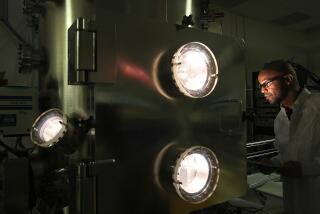From aerospace to empty space to Space Age facility
- Share via
On a once-vacant Downey lot, steel beams crisscross to form an unremarkable skeleton.
But painted on the exterior of the film studio next door is a starry, twinkling universe, hinting at the striking, Space Age building to come -- Downey’s new landmark science center.
The $18-million Columbia Memorial Space Science Learning Center, to be clad in a curving, futuristic layer of silvery gray aluminum and glass, is expected to draw students from across Southern California to rotating exhibits about space exploration.
The center is scheduled to open by the end of summer, said Alex Guerrero, executive vice president of Tower General Contractors, which is building the center.
Downey, an aviation and aerospace hub for decades, touts itself as the perfect home for the new space center. The 2-acre development is within spitting distance of the 1960s American headquarters of the U.S.-Soviet space race, where the Apollo moon modules were born.
“We can pull the history from right next door,” said Scott K. Pomrehn, assistant to the Downey city manager.
Walking through the construction site last week, Pomrehn pointed out an area designated for the lab where children will build and program robots, and the two-story atrium where youngsters can engineer a Mars probe landing.
The city-funded 18,500-square-foot facility will also feature the only space shuttle flight simulator in Southern California. The faux shuttle will offer students the chance to rattle around like astronauts as it launches and lands, as well as to direct the spacecraft from the perspective of a mission controller. Visitors will be able to search an aerospace research database backed by the Jet Propulsion Laboratory in La Canada Flintridge, Pomrehn said, as well as simulate landing a World War II-era plane like those once built in Downey.
With some financial and scientific support from NASA, organizers are shooting for a “wow factor,” Pomrehn said.
The building will sit on the edge of a new 11-acre park, home to a planned memorial to the seven Columbia astronauts who perished in 2003 when the space shuttle disintegrated upon reentry to the Earth’s atmosphere.
A giant photo collage in the museum will honor the Columbia mission, and exhibits will describe some of the scientific experiments that took place onboard.
The ill-fated Columbia was one of six space shuttle orbiters partially built in Downey. Aviation and aerospace are integral to the city’s history, and center organizers hope to honor that tradition through oral histories and artifacts donated by residents. At its peak in the 1960s, 35,000 people worked in the aerospace industry there.
Next door to where the science center is rising is a massive warehouse -- now the film studio -- that once housed aircraft manufacturing and missile development. The aerospace plant closed in 1999, and for a while, the site “was a run-down area,” said Downey Mayor David R. Gafin.
Now, he said: “We are pushing hard toward the future.”
Planners anticipate that exhibits such as the original wooden mock-up of the Columbia, and the prototype of an Apollo space capsule used for an unmanned mission, will rocket “space back into the minds of children,” Gafin said.
But significant work -- and fundraising -- remains to be done.
City officials said they were close to hiring an executive director for the learning center. They have yet to determine how much entrance fees will be but hope to secure educational grants that would enable many schoolchildren to visit for free. The center is expected to cost $1 million a year to run; the money for construction has already been earmarked. Officials plan to hire up to three full-time employees and rely on volunteer docents for additional staffing.
City leaders hope to power the center on natural-gas fuel cells, similar to those used in spacecraft, and have discussed establishing a summer space camp there.
And planners, Pomrehn said, have asked the Smithsonian Institution to lend the center a must-have for any space museum worth its salt: a moon rock.
--
susannah.rosenblatt@latimes.com
More to Read
Sign up for Essential California
The most important California stories and recommendations in your inbox every morning.
You may occasionally receive promotional content from the Los Angeles Times.













